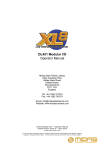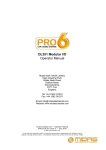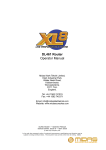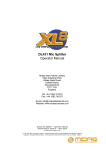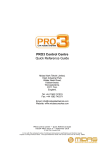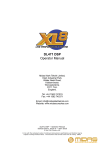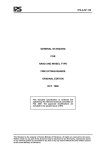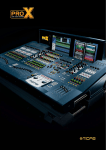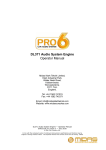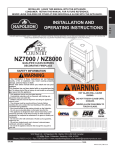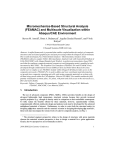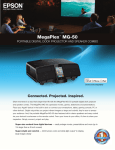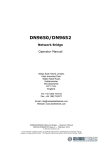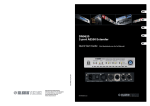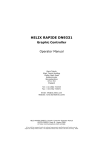Download Midas V190 Specifications
Transcript
Midas Consoles and Digital Audio Networks 2010 Midas Consoles and Digital Audio Networks 2010 WALTER NASH ROAD, KIDDERMINSTER, WORCESTERSHIRE. DY11 7HJ. ENGLAND. TEL:+44 1562 741515 FAX:+44 1562 745371 www.midasconsoles.com DOC05-MIDAS 01-06-2010. Due to company policy of continual improvement we reserve the right to change the specifications of any Midas product without prior notice. All manufacturer and product names used in this datasheet are trademarks of their respective owners, which are in no way associated or affiliated with Midas Klark Teknik Ltd. These trademarks are used solely to identify the third party interfaces supported by the Klark Teknik DN9650 Network Bridge. The term AES50 is used solely for identifying a compliant implementation of AES50, AES standard for digital audio engineering - High-resolution multi-channel audio interconnection (HRMAI). Published by Audio Engineering Society, Inc. Copyright ©2005 by the Audio Engineering Society, New York, NY., USA. www.aes.org. Information subject to change. E&OE © 2010 Midas Klark Teknik Ltd. Forty Years of Innovation and Leadership Midas have a long history of Innovation and leadership in the world of audio mixing consoles, which continues to this day. Originally formed in 1970 by Jeff Byers and Charles Brooke, Jeff became fascinated by the concept of improving and refining professional audio systems, and so Midas went on to develop the first fully integrated modular audio system, comprising consoles, crossovers, amplifiers and speaker systems in conjunction with Dave Martin, which became the calibrated Midas/Martin system of the 1970’s. The first Midas mixer to achieve major success was the PR04, a modular console, and forerunner to the XL3, the first Midas to feature VCA groups, and the world’s first truly dualpurpose console. In 1990, this innovation changed the way the a generation of engineers approached the art of mixing, opened new creative possibilities and set the scene for the greatest analogue console ever built, the XL4. The XL4 set the benchmark for the next decade. Audio engineers were amazed at the sheer depth and scope of what they were able to achieve with the unbeatable combination of the XL4’s audio performance and comprehensive moving-fader automation. Many elements of this legendary console are still available to today’s engineers in the current range of Midas digital mixing systems. Always seeking to redefine the boundaries of audio performance and flexibility, the turn of the century saw the launch of the ubiquitous Heritage 3000. Midas employed the ultimate distillation of design and experience into creating the perfect roadworthy touring console. The Heritage 2000 and the theatre orientated Heritage 1000 complete the line up. Innovation continued into the new millennium with the Legend 3000, the world’s first Tripurpose console, and the Verona and Siena, which revitalized and redefined the market for the medium format console. Then, in 2006, Digital went Midas. When the Midas XL8 was launched, it set new standards for audio quality, ease of use, power, flexibility, and creative potential which, in 2010, have yet to be matched. No other live digital audio console can compete with the sample-synchronous audio performance, expandable network topology, and sheer ease of use which are the trademarks of all Midas digital systems. The XL8 has become the system of choice for prestigious installations, major touring artistes, Theatres and concert venues the world over, including many unique international events where compromise is not an option. PRO6 strengthened Midas’ digital range in 2008, which shares the same sample synchronised audio performance as the XL8 and its extensive networked audio system. The PRO6 is a common sight at front of house and monitor positions in concert touring as well as global events such as the Eurovision Song contest where a number of PRO6s form part of a large audio network along with XL8s. The PRO3 and PRO9 have since been added creating the PRO series, now offering a choice from 48 up to 88 simultaneous mixed inputs allowing even more touring riders and professional installations to take advantage of Midas’ digital features. All Midas digital consoles feature multiple types of channel EQ and dynamics plus an extensive set of fully time aligned and dynamically re-patchable effects processing devices. The comprehensive theatre grade scene automation system can also dynamically reconfigure 800+ inputs and outputs on a scene by scene basis. The ground breaking ultra low latency audio networking technology developed for the XL8 and PRO series is now available for many more applications with the introduction of the Midas standalone digital snake and audio distribution range. Which includes an affordable fixed 48 mic in/16 line out system, a fully flexible 64/64 system and a high performance mic splitter system with up to 3km dual remote ends. In 2010 Digital has definitely gone Midas. Midas Digital Sound Quality The Midas reputation for fantastic audio quality has evolved over 40 years of development and research. By designing the best mic pre’s, equalisation and using the superior components. Midas has carried this tradition into the digital realm, by adding the best converters and custom processing algorithm to the mix Midas, takes audio quality to another level. In addition Midas digital systems are the only live sound systems in the world to have a comprehensive and automatic latency management system. Which, in addition to managing all internal routing and processing latency, also includes compensation for external analogue inserts. This means that all audio samples are synchronised before summing, resulting in absolute phase coherency at all outputs. Midas digital feels, as well as sounds superb. All the variable controls on the console are genuine analogue high precision potentiometers, not mechanical encoders. These access the FPGA-DSP engine through precision instrumentation A-D converters and Midas’ custom interpolation algorithms. This means that as well as all audio, all operator input is fully interpolated to ensure a linear, analogue-style, silky smooth “feel” to your mix. The Midas microphone pre-amp is the one by which all others are judged. Still built from discrete components, and still based on the designs which were so successful in the legendary Midas analogue consoles such as the XL3, XL4 and Heritage, the current expressions in the XL8 range and PRO Series sound better than ever. Whether you want pristine, transparent reproduction, or that renowned Midas warmth and colouration, Midas’ dual (analogue and digital) gain stages enable you to shape the mic amps’ character according to your own preference. A major problem affecting many digital consoles is a lack of attention to delay management. All digital processing takes time to run – typically just a few samples, but never zero. ADCs and DACs have much bigger delays (typically a few milliseconds) so if analogue insert points are used, the channel in question will be delayed significantly relative to the others Mix engineers working on analogue consoles routinely combine signals with different signal paths and processing and expect to do the same with digital. On many current digital consoles, combining signals in this way leads to the summing of signals that are in effect partly out of phase. This causes undesirable “comb filtering” effects, where specific frequencies are cancelled out completely. All Midas digital consoles have comprehensive automatic time alignment to correct any path related delays. Plus the additional latency introduced by the A to D conversion on the analogue inserts is also automatically compensated. Unique to Midas digital are the I/O and DSP units which can be freely distributed into multiple locations. In particular I/O units can be placed exactly where they are needed – on the stage, around the auditorium, at FOH or remotely in a broadcast truck. Midas’ digital audio network is easily configurable to route signals from where and by when they are needed since the patching is done a scene-by-scene basis. Every transition of a network adds delay. Midas networks have only 70 micro-seconds of latency per hop so even a multi-hop routing has negligible aggregate delay (latency) making it perfect for in-ear monitoring. All inputs and all outputs are time-aligned to sample accuracy, no matter where they are in the network or how they are routed. This is another major contributor to the performance of a Midas digital console and that magical Midas sound. Midas Digital Audio Systems VCA and POPulation Groups With the advent of digital technology consoles channel counts and processing features have grown to a point where it is just not practical to have all controls physically available at the same time. Additionally the logistical advantages of smaller control surfaces are attractive. Midas’ unique approach to solving this problem is to mirror the natural work flow used by sound engineers and to provide control and supporting feedback of system status at all levels, from the highest overview to the finest detail. This encourages the development of a mental picture, or “Mind Map”, of the whole system even though at times focus may be on one or two specific functions. For example: as a default channel faders are not layered but scrolled; so the console faders act as a window onto the available channels in the system and allow you to think of them as a simple linear progression, like on an analogue console or a channel list, rather then having to remember which layer things are on. Unlike analogue consoles in this way the console comes to you rather then the other way around. But this is only the beginning. At the heart of any Midas control centre are the VCA faders that provide primary mix control of multiple channels (typically grouped into musical clusters by sound engineers). A unique innovation in this established mixing approach is the ability to access all the channel faders belonging to any of the VCA groups at the press of a switch: again the channels come to you rather than having to go looking for them. VCA groups can be Solo’d and Muted. If you think of the VCA faders as if they were each containers for all the channels they control then finding channels becomes a natural and easy task. This method is further expanded through the provision of user customised POP (POPulation) groups each of which can contain any combination of channels that you want to accesses instantly at the press of a switch. Rather like a VCA without a fader. This work flow approach is applied to every area of the control surface ensuring ease of use and appropriately fast access to all controls. To help further improve the “Mind Map” live sound engineers have typically used colour when navigating mixing consoles by applying different coloured adhesive tape and swapping coloured fader knobs to help make console navigation faster and more intuitive. Midas have taken this established principle of channel recognition and applied it to VCA and POPulation groups with assignable colour-coding and digital write on buttons. VCAs and POP Groups are deceptively easy to set up and use. Simply press and hold the desired VCA or POP group select button until it starts to flash. Press the channel select buttons to assign to VCA or POP group. Press and the hold VCA or POP group select button, until flashing stops, to confirm selections. Selecting a VCA or POP group will bring all of the members of that group to the designated area of the control surface, populating from the VCA area outwards. If the group has more members than visible channels, the group can be viewed by scrolling the input bay. Effects Processing Midas digital consoles include an ever expanding library of effects processing devices. Which includes: AA KT DN780 reverb Hall Plate Room Chamber ALIVE! Non-linear Reverse Infinite room AA Multi-band compressor AA Stereo pitch shifter AA Square ONE 8-channel dynamics processor AA KT DN370 Graphic EQ AA Stereo delay AA Stereo flanger AA Stereo phaser The effects devices are presented as a virtual rack of units. XL8 can have up to 16 multichannel devices (plus 32 Graphic EQs), PRO Series has 6 or 8 devices depending on model (plus Graphic EQs). The effects device types can be changed and/or re-patched on a scene by scene basis. There are many patching options for the effects processors and graphic EQs. Some of these are: AA Assign to any insert send/return AA Assign to any network input or output AA Assign FX out to aux return AA Assign FX in to aux send (post fade) AA Assign FX out to bus direct in AA Assign FX in to channel direct out The Midas’ FX and dynamics are incorporated within the systems automatic delay management system, so that wherever they are patched, the audio will be absolutely phase-coherent when summed into the mix. Graphic EQs You can have up to 36 1/3 octave Klark Teknik GEQs on a PRO series and up to 51 on an XL8, which can be patched into any output or insert point and can be control by a Klark Teknik DN9331 Rapide fader remote which is standard on the XL8 and an option on the PRO Series or from control on the console surface. Automation All Midas digital consoles are purpose-designed for easy, instant-access to all key functions when mixing, however, should the operator require the console to manage mundane repetitive tasks, or control complex and wide-reaching changes during a performance, the onboard automation system can handle all requirements with ease. Each show file within the consoles memory can contain many hundreds of “scenes” which can be individually recalled the instant their settings are required. Scenes can be recalled instantly, or with a configurable crossfade time, for more subtle changes, or by programming user-configurable crossfade “groups” complex timed events can be prepared with instant user-intervention if required including manual control of crossfades. Each scene contains every parameter on the system, including all audio parameters, network routing, console configuration, FX type, routing and settings, even VCA and POP group deployment and screen brightness can be pre-programmed into a scene recall! MIDI or GPIO (contact closure) ports, provide control of external devices or allow the console to respond to external prompts, permitting many external 3rd. party devices to be incorporated into the Midas automation system. MIDI, GPIO, and internal (crossfade and text note)“events” all have a comprehensive palette of options which include all the usual MIDI parameters, plus the ability to assign time delays to the implementation of the programmed event. The dedicated automation GUI displays all scenes programmed into the show, and provides visual feedback for all automation events, an area for text notes, and the facility to quickly re-order the scenes, should the set-list or running order change at the last second! For those times when a well-rehearsed and programmed show does change at the last second, the console has dedicated hardware controls for every channel enabling the operator to “safe” any parameter from computer control should the need arise. Software control of scene-specific automation “scope” is also provided, as well as the ability to “cut and paste” any real-time parameter changes to subsequent scenes via the onboard SHOW EDITOR. Patching Midas digital systems are much more than a “mixer” – they are complete digital audio distribution networks. The XL8 has a network capacity of 432 inputs and 432 outputs, and the PRO3, 6, and 9 all have capacities of 288 inputs and 294 outputs. All of these network connections can be patched and routed independently of the audio passing through the “mixer”. Any correctly-directioned connector can be mapped to any node on the mixer, and any correctly-directioned node elsewhere on the network, simultaneously! Modular I/O devices (DL451, DL351 and PRO3/6/9 control centres) feature a modular, user-configurable card-based system which permits any combination of analogue and/or digital inputs and/ or outputs to be deployed depending upon the requirements of the event. The routing GUI is presented to the user in a highly visual, easily understood pictoral format, enabling quick, easy operation and comprehension of a large and potentially complex audio network. The format, configuration, routing and patching of the entire network can be re-configured instantaneously on a scene-by-scene basis by using the consoles automation system. Areas A and B Midas’ digital control surfaces can be divided into two areas, Area A and Area B facilitating dual operator use. The input channel area on the far right of the surface (4 channels on a PRO series and 8 channels on an XL8) can be designated as Area B by selecting the Area B button located below the scroll buttons in the “input select” area. The input control channels on the right-hand side of the Control Centre can now be used independently of those on the left. VCA and POPulation groups can be pre-selected to populate either Area A or B. This means a group of inputs can populate different areas of the surface. The engineer brings the required inputs to their local work surface, where they are quickly and easily identified and changes implemented. Each area has its own Solo bus to allow engineers to listen independently to their mix via 2 separate headphone jacks. Third Party System Integration The Midas XL8 range and PRO Series systems incorporate several special features to aid real world integration with other important sub-systems. The Midas digital snakes (HyperMAC), both CAT-5e and Fibre Optic versions, carry embedded control signals for general usage. Signals carried include standard Ethernet traffic, MIDI messages and GPIO (general purpose input and output signalling). This is a great advantage since it avoids extra cables, extends the range of, for example MIDI, a long way beyond normal limits and provides a free Ethernet range extension. The Ethernet tunnel provides a 10Mbit/sec standard Ethernet connection from an Ethercon RJ45 connector on the control surface to a similar connector on the stage router unit (DL461, DL361) for use by third parties. Applications include carrying control signals from a PC at FOH to a radio mic receiver rack on stage and similarly, control signals from a PC to a system controller on stage. External network hubs can be used to connect many different systems together via the MIDAS snake, which also provides redundancy in case of cable damage. MIDI messages and GPIO (contact closure) signals can be sent and received by the Midas Console Automation System to local connectors at the console position and remotely to Midas I/O devices which can be 500m away. The control surfaces incorporate a KVM switch (Keyboard – Video – Mouse). This switch allows one screen on the control surface plus the keyboard and trackball to be switched to one of three external computer connectors. This is a great way of reducing “clutter” at the control surface position. A control surface screen, keyboard and trackball can be used to control up to three other systems where the computers are placed out of harms way. These external systems, such as ProTools*, Waves* Multi-Rack, Shure* UHF-R radio mics and Dolby Lake* System Controllers, then appear on a Midas control surface screen and are controlled by the surface keyboard and trackball. As described above the Ethernet tunnel can then be used to pass the Ethernet messages from these computers to the devices they are controlling on stage via the Midas snake. As an extra refinement the automation system can be used to communicate with external systems via MIDI thereby integrating these systems into the Midas scene automation. * All trademarks acknowledged. XL8 Live Performance Systems Introduction Digital goes Midas. The industry held its collective breath when the XL8 was unveiled in 2006 as this was not merely another digital mixing console. It brought audio control and distribution, in fact all aspects of the live performance to one single control centre. Being a Midas it coupled sound quality, flexibility and reliability with an ease and familiarity of use unrivalled by other digital control surfaces. The XL8 has been designed so the engineer doesn’t have to think in terms of numbers, pages or layers. The user navigates the system and identifies channels by colours and groupings, which they themselves create. This method allows an individualised approach to mixing, rather than working within hardware-dictated numerical limitations. Overview: AA Five “Daylight Visible” Screens with 3-way KVM switch AA 432 inputs and 432 outputs connectivity AA Direct Point to Point routing, any in to any out AA 4 I/O box alternatives: distributable I/O with 600m range AA 112 mix inputs onto 51 buses AA 12 VCAs AA 8 POPulation Groups AA 3 EQ types and 5 dynamics styles as standard AA 16 effects devices AA Up to 51 1/3 octave graphic EQs (37 standard) AA Configurable “Area B” for dual operators AA Separate solo systems for areas A and B AA 55 P&G Motorised Faders AA Surround panning including 5.1, Quad and LCRS AA 500m bi-directional 192+192 channel redundant snake AA All I/O units connected by AES50 bi-directional 24+24 channel CAT-5e AA All I/O can be 100 metres from Front of House or Stage router positions AA 8 AES50 Ports on the Control Centre and 10 on stage router (DL461) for I/O expansion AA Scene by scene re-assignment of routing and effects AA All DSP processing, AD/DA conversion and networked audio is at 96kHz sample rate AA All DSP processing, AD/DA conversion and networked audio is fully and automatically time aligned AA Extensive and comprehensive scene automation system AA Show files are fully compatible across software releases and all Midas digital consoles AA MIDI and GPIO automated events at FOH and stage AA Ethernet tunnel provided for 3rd part communications through snake AA Dual-Redundant Linux Control Computers AA Dual-redundant audio networks AA DSP, I/O and controls redundancy AA Single and dual (for FOH + monitors) versions AA Three year factory warranty Accessories: AA Klark Teknik DN9696 96 track High Resolution Audio Recorder AA Klark Teknik DN9650 Network Bridge (MADI, Dante, Aviom, Ethersound, CobraNet) XL8 Live Performance System Touring The touring version of the XL8 Live Performance System has been especially configured for high profile concerts, festivals and major events. Main inputs are connected via DL431 remote control 5-way mic splitters which have three fully independent non-interacting mic pres per input. Two of these are remote controllable (2.5dB steps) and the third is fixed gain feeding out as analogue via isolating transformers. The two remote control mic pres separately feed both Midas digital networks and analogue outputs. The DL431 units can be shared by the FOH and monitor XL8 consoles providing a cost effective system but still retaining independent analogue mic pre remote gain control for the two engineers. Both Midas digital network connections are duplicated for redundancy and the DL431 also has dual-redundant power supplies. Audio outputs are routed to any of the 5 supplied DL451 configurable I/O units, each of which can have up to 24 outputs and 24 inputs depending on I/O card options fitted. Any DL451 (and DL431) unit can be up to 100m from either the stage router or FOH location. The stage router can be up to 500m from FOH. All of these connections are dual redundant, as are the network routers. XL8 Touring Configuration: AA Five “Daylight Visible” Screens with 3-way KVM switch AA 432 inputs and 432 outputs connectivity AA 112 mix inputs onto 51 buses AA 12 VCAs AA 8 POPulation Groups AA 16 effects devices AA Up to 51 Klark Teknik EQa with DN9331 Rapide control AA Configurable “area B” AA 500m bi-directional 192+192 channel redundant snake AA Local I/O 1 x DL451 Up to 24 in / 24 out configurable I/O AA Stage I/O 4 x DL451 Up to 24 in / 24 out configurable I/O 4 x DL431 24 in 5 way split: fixed configuration 2 x DL461 Audio System Signal Router AA Klark Teknik DN9331Rapide Graphic Controller as standard AA Control centre supplied in flight case Additional I/O Box Options: AA DL251 48 in / 16 out fixed configuration I/O AA DL351 Up to 64 in / 64 out configurable I/O I/O Card Options: AA DL441 Analogue Mic / Line Input “I” card AA DL442 Analogue Output “O” card AA DL443 8 Analogue Line In and 8 Analogue Line Out “TRS” card AA DL452 AES/EBU Input and Output “D” card AA DL444 “D Sub” card Control Centre Weight and Dimensions: Width 1875mm x Depth 1054.27mm (73.82” x 41.51”) Weight: 159kg (350.53lbs) * *weights are approximate and out of flight case XL8 Live Performance System Install The Install Version of the XL8 Live Performance System has been especially configured to be cost effective for permanent installations. The I/O XLRs are replaced by high-density D-type connectors. Each of the four remote DL451 24 channel in and 24 channel out I/O boxes can be separately placed up to 100m from the stage router unit, which can itself be up to 500m from the control surface. The DL444 I/O cards in the DL451 frame each have 8 channels of remote controlled Midas mic pre with 2.5dB steps as well as 8 line level outputs. This version is ideally suited to theatres, multi-purpose venues, house-of-worship (and touring applications where 5-way active mic split may not be required). XL8 Install Configuration: AA Five “Daylight Visible” Screens with 3-way KVM switch AA 432 inputs and 432 outputs connectivity AA 120 primary inputs AA 12 VCAs AA 8 POPulation Groups AA 16 effects devices AA Up to 51 Klark Teknik EQa with DN9331 Rapide control AA Configurable “Area B” AA 500m bi-directional 192+192 channel redundant snake AA Local I/O 1 x DL451 preconfigured with DL441 “I” card, DL442 “O” card and DL452 “D” card AA Stage I/O 4 x DL451 preconfigured with DL444 “D Sub” cards AA 2 x DL461 Audio System Signal Router AA Control centre supplied in crate Additional I/O Box Options: AA DL251 48 in / 16 out fixed configuration I/O AA DL351 Up to 64 in / 64 out configurable I/O AA DL431 24 in 5 way split: fixed configuration I/O I/O Card Options: AA DL441 Analogue Mic / Line Input “I” card AA DL442 Analogue Output “O” card AA DL443 8 Analogue Line In and 8 Analogue Line Out “TRS” card AA DL452 AES/EBU Input and Output “D” card AA DL444 “D Sub” card Control Centre Weight and Dimensions: Width 1875mm x Depth 1054.27mm (73.82” x 41.51”) Weight: 159kg (350.53lbs) * *weights are approximate and out of flight case Accessories: AA Klark Teknik DN9331Rapide Graphic Controller XL8 Variants The pre-packaged Touring and Install versions of the XL8 represent just two examples of I/O connectivity. The comprehensive and easy to use Midas networking allows for many variations of I/O type and connectivity and covers a wide range of system costs. Please contact your distributor to discuss other options. Audio System Signal Router Midas DL461 Audio System Signal Processor Midas DL471 The DL461 is a 3U 19” rack unit, which performs the stage-to-console link using a single CAT-5e cable (under 100 metres) or fibre-optic link (up to 500 metres) for the XL8. The DL471 is a 1U 19” rack unit, which forms part of the XL8 modular DSP engine. In addition to audio and control connections to the ten DSP modules. It features ten fully dual redundant AES50 connections for local I/O, as well as BNC and AES3 word clock interfaces and Ethernet tunnel. Dual redundant DL461s are supplied with each XL8 system. Overview: AA Two DL461s included in a XL8 Live Performance System AA Integrated open-architecture AES50 digital audio distribution AA Fully duplicated network for redundancy AA Up to 100 metres of dual redundant connectivity between hardware elements with CAT-5e AA Up to 500m of dual redundant connectivity between hardware elements with optical fibre AA Automatic integral delay management system - audio outputs time and phase coherent AA Flexible, expandable hardware system AA Ethernet TCP-IP for third parties AA 3U It features its own discrete power supply, AES50 and Ethernet interfaces, as well as a dual, ultra high-speed, contra-rotating and self healing data loop for direct processor to processor communications. Each XL8 system includes ten DL471 units of which one is a redundant hot spare (n+1 resilience model). Overview: AA Ten DL471s included in a XL8 Live Performance System AA Dual redundant AES50 ports AA Dual redundant Ethernet ports AA Advanced FPGA architecture AA 4.8 Gigaflops of processing power per DL471 AA 1U PRO Series Introduction The Midas PRO Series Live Audio Systems employs technology developed from the class-leading XL8, offering the same exemplary sample - synchronised audio performance. The PRO series can provide up to 104 simultaneous input processing channels and up to 35 discrete mixes in monitor mode, all of which feature EQ and a choice of dynamics processing options. By adding additional I/O hardware the PRO series network can be expanded to 288 inputs x 298 outputs with point-to-point routing anywhere within the network which can then be patched and routed on a scene-by-scene basis via a powerful snapshot automation system. The PRO series FX and dynamics algorithms are more than superb quality, easy-to use SHARC-based FX processing. They are incorporated within the automatic delay management system, so that wherever they are patched, the audio will be absolutely phase-coherent when summed into your mix. It is possible to assign up to 36 1/3 octave Klark Teknik DN370 graphic EQs, for demanding monitor applications, all of which can be controlled using the optional Klark Teknik DN9331 Rapide moving fader remote. All of this in addition to the four types of compression available on inputs, and five types on outputs. FX options, configurations, settings and patching can change completely with each scene recall. The possibilities are almost endless. Reliability is designed into all Midas products, and all PRO Series hardware elements feature redundant power supplies as standard. The FPGA processing engine is of modular construction, with the option of a spare module which will automatically deploy in the event of an engine module failure (n+1 model). Due to its modular configuration the DSP engines of both the PRO3 and PRO6 can be loaded and upgraded to PRO9 specification. PRO Series digital audio transport uses the international AES50 standard, featuring feedforward error correction which provides superior protection against lost data packets and synchronization issues when compared to other Ethernet based systems. All links between PRO series hardware elements support redundant cables for copper and optical options on the PRO6 and PRO9. The Control Centre houses dual redundant Linux master control computers (MCs), both running full versions of the relevant PRO Series Linux software. Either MC is capable of running the entire system on its own and control can be switched between the two without any loss of audio. Overview: AA Dual “Daylight Visible” Screens with 3-way KVM switch AA XL8-Style “Fast Zones” AA XL8-Style Dual Operator “Channel Strips” AA 10 VCAs AA 6 POPulation Groups AA Configurable “Area B” AA 16 Input Faders AA Surround panning including 5.1, Quad and LCRS AA Dual-Redundant Linux control computers AA 3 AES50 ports on the Control Centre for I/O expansion and XL8 connectivity AA 8 AES50 ports on stage end of snake for I/O expansion AA Up to 24 configurable inputs and 24 configurable outputs on the Control Centre* AA Three year factory warranty Accessories: AA Klark Teknik DN9331 Rapide Graphic Controller AA Klark Teknik DN9696 96 track High Resolution Audio Recorder AA Klark Teknik DN9650 Network Bridge (MADI, Dante, Aviom, Ethersound, CobraNet) PRO3 Live Audio System The Midas PRO3 Live Audio System provides entry to the PRO Series of consoles and will ensure that even more touring riders and professional installations can take advantage of Midas’ digital features. PRO3 naturally features the legendary and much-loved Midas sound characteristics, which have their roots in the classic Midas analogue consoles. It also includes the overwhelmingly successful VCA and POPulation groups, which allow users to navigate channels intuitively, without the hindrance of layers or pages of faders. It also benefits from the same comprehensive choice of effects and dynamics processing as the PRO6 and XL8, including the much-acclaimed XL8 compressor styles. The PRO3 brings these features and more within reach of tighter budgets, offering 48 input channels with remote controlled mic pres, 27 buses and six stereo effects. At the heart of the PRO3 is another new arrival from Midas, the DL251 fixed format, 5U I/O rack, designed as a more cost-effective solution for those not requiring the flexibility of Midas modular I/O hardware. However should investors require more connectivity over time, a simple and affordable upgrade path supersizes the system to the fully-loaded, 88-channel PRO9 with additional hardware and firmware upgrades. PRO3 Configuration: AA 288 inputs x 294 outputs (max capacity) point-to-point routing anywhere within the Network AA 48 primary inputs AA 8 return inputs AA Up to 72 simultaneous mix channels AA 16 Group/Aux & 8 Matrix - 24 Mixes in “monitor” mode AA 27 mix busses AA 10 VCAs AA 6 POPulation Groups AA 6 FX devices AA Up to 28 KT Graphic EQ’s - with optional DN9331 Rapide control AA Configurable “Area B” AA Surface I/O DL443 TRS card 8 in / 8 out fitted as standard Plus 2 expansion slots for additional cards AA Stage I/O DL251 48 in / 16 out fixed configuration AA 100m bi-directional 192+192 channel CAT-5e redundant snake AA Control Centre supplied in shipping crate Additional I/O Box Options: AA DL431 24 in 5 way split: fixed configuration I/O AA DL351 Up to 64 in / 64 out configurable I/O AA DL451 Up to 24 in / 24 out configurable I/O I/O Cards Options: AA DL441 Analogue Mic / Line Input “I” card AA DL442 Analogue Output “O” card AA DL443 8 Analogue Line In and 8 Analogue Line Out “TRS” card AA DL452 AES/EBU Input and Output “D” card AA DL444 “D Sub” card Control Centre Weight and Dimensions: Width 1365mm x Depth 924mm (53.7” x 36.4”) Weight: 97Kg (213.4lbs) Packaging Options: AA Control centre flight case AA 16U flight case for DL371 DSP and I/O PRO6 Live Audio System The Midas PRO6 is the second networked digital audio system from Midas and is at the heart of the PRO Series Live Audio Systems. The PRO6 can provide up to 64 simultaneous input processing channels and up to 35 discrete mixes in monitor mode, all of which feature EQ and a choice of many dynamics processing options. By adding additional I/O hardware the PRO6’s network can be expanded up to 288 inputs and 294 outputs. These connections can be patched and routed on a scene-by-scene basis, by use of the PRO6’s powerful snapshot automation. As with all the PRO Series the PRO6 benefits from the mix and match of all the Midas I/O box options, from the fixed configuration DL251 stage box to the highly acclaimed DL431 24 channel 5-way mic splitter. Flexibility can be further increased by adding the Klark Teknik DN9650 digital format converter offering MADI and Dante connectivity. Users can navigate the channels intuitively without resorting to layers with the aid of Midas’ VCA and POPulation groups. It naturally features the legendary and muchloved Midas sound characteristics with comprehensive choice of effects and dynamics processing, including the much-acclaimed XL8 compressor styles. The PRO6 can to the fully-loaded at a later date to an 88-channel PRO9 with additional hardware and firmware upgrades. PRO6 Configuration: AA 288 inputs x 294 outputs (max capacity) point-to-point routing anywhere within the Network AA 56 primary inputs AA 8 return inputs AA Up to 80 simultaneous mix channels AA 16 Group/Aux & 16 Matrix - 32 Mixes in “monitor” mode AA 35 mix busses AA 10 VCAs AA 6 POPulation Groups AA 8 FX devices AA Up to 36 KT Graphic EQ’s - with optional DN9331 Rapide control AA Configurable “Area B” AA Standard surface I/O DL443 TRS card 8 in / 8 out DL452 AES/EBU Input and Output “D” card DL442 Analogue Output “O” card AA Stage I/O DL351 56 in / 8 out configurable I/O AA Dual-Redundant HyperMac (192x192) CAT5-e digital snake included AA Fibre Optic connections for optional maximum 500 metre snake AA Control centre supplied in flight case AA 16U flight case supplied for DL371 DSP and DL351 I/O Additional I/O Box Options: AA DL431 24 in 5 way split: fixed configuration I/O AA DL251 48 in / 16 out fixed configuration I/O AA DL451 Up to 24 in / 24 out configurable I/O I/O Card Options: AA DL441 Analogue Mic / Line Input “I” card AA DL442 Analogue Output “O” card AA DL443 8 Analogue Line In and 8 Analogue Line Out “TRS” card AA DL452 AES/EBU Input and Output “D” card AA DL444 “D Sub” card AA Option of 150m Fibre Optic cable Control Centre Weight and Dimensions: Width 1365mm x Depth 924mm (53.7” x 36.4”) Weight: 97Kg (213.4lbs)* *weights are approximate and out of flight case PRO9 Live Audio System The Midas PRO9 sits at the top of the Midas PRO Series, featuring a massive 88 channel input count and 35 buses, with the dual stage boxes offering placement flexibility up to 200m apart and 500m from the FOH position. The PRO9 benefits from the full range of Midas I/O box options, including the DL251 fixed format stage box, the highly acclaimed DL431 24 channel 5-way mic splitter offering three mic preamps per channel and dual digital network connections, both with full redundancy. Flexibility can be further increased by adding the Klark Teknik DN9650 digital format converter offering MADI and Dante connectivity. The Midas PRO9 comes complete with the features that have been made popular by established Midas digital systems, the XL8 and the PRO6. This includes the successful VCA and POPulation groups, which allow users to navigate channels intuitively, without the confusion caused by layers or pages of faders. It features the legendary and much-loved Midas sound characteristics, which have their roots in the classic Midas analogue consoles. The PRO9 also benefits from the same comprehensive choice of effects and dynamics processing as the PRO6 and XL8, including the much-acclaimed XL8 compressor styles. Expandable modular connectivity means the system can be upgraded to meet any applications. PRO9 Configuration: AA 288 inputs x 294 outputs (max capacity) point-to-point routing anywhere within the Network AA 80 primary inputs AA 8 return inputs AA Up to 104 simultaneous mix channels AA 16 Group/Aux & 16 Matrix - 32 Mixes in “monitor” mode AA 35 mix busses AA 10 VCAs AA 6 POPulation Groups AA 8 FX devices AA Up to 36 KT Graphic EQ’s - with optional DN9331 Rapide control AA Configurable “Area B” AA Standard surface I/O DL443 TRS card 8 in / 8 out DL452 AES/EBU Input and Output “D” card DL442 Analogue Output “O” card AA Stage I/O DL351 56 in / 8 out configurable I/O DL451 24 in configurable I/O AA Dual-Redundant HyperMac (192x192) CAT5-e digital snake included AA Fibre Optic connections AA Control centre supplied in flight case AA 16U flight case supplied for DL371 DSP and DL351 I/O Aditional I/O Box Options: AA DL431 24 in 5 way split: fixed configuration I/O AA DL251 48 in / 16 out fixed configuration I/O I/O Card Options: AA DL441 Analogue Mic / Line Input “I” card AA DL442 Analogue Output “O” card AA DL443 8 Analogue Line In and 8 Analogue Line Out “TRS” card AA DL452 AES/EBU Input and Output “D” card AA DL444 “D Sub” card AA Option of 150m Fibre Optic cable Control Centre Weight and Dimensions: Width 1365mm x Depth 924mm (53.7” x 36.4”) Weight: 97Kg (213.4lbs)* *weights are approximate and out of flight case Audio System Engine Midas DL371 Audio System Modular I/O Midas DL351 The PRO Series processing engine is a 7U 19” rack mount unit, which houses up to 7 audio processing modules and routing hardware. Employing advanced FPGA architecture, it has three removable power supplies, only two of which are required for full operation. The power supplies are auto-voltage sensing, auto-switchover, hot-swappable, are fitted with locking AC connectors and are identical to, and therefore interchangeable with the PSU’s in the PRO Series Control Centre. The DL351 is a 7U 19” rack unit, can provide a maximum of 64 audio inputs and 64 audio outputs. It has the same user-configurable card format as the DL451 but has the capacity to house up to 8 cards, which can be any combination of 8 analogue mic/line in, 8 analogue out (XLR), 8 analogue TRS line level in and out, 8 digital in and out (4 AES/EBU pairs) or a 25 pin D sub card with 8 analogue mic/line inputs and 8 outputs. The engine has dual-redundant HyperMac ports (both CAT-5e and Optical on the PRO6 and PRO9) which provides the digital equivalent of a 384-way (192 in + 192 out) multi-core between the stage and FOH. There are also eight AES50 ports, which facilitate connections to the PRO Series DL351 stage box, and/or other AES50 I/O hardware. It is also possible to use any PRO Series with DL251, DL351, DL451 and DL431 plus the Klark Teknik DN9696 Hi Resolution Audio Recorder and DN9650 Network Bridge. The processing engine is loaded with 4 modules for a PRO3, 5 for a PRO6 and 6 for a PRO9 in the standard configuration, with an extra-cost option for an n+1 redundant spare module. Overview: AA One DL371 included in a PRO Series Live Audio System AA N+1 PSU redundancy AA Dual redundant HyperMAC ports AA Eight AES50 ports AA Ethernet tunnel connection AA Word Clock and AES3 sync connections AA Advanced FPGA architecture AA Upgrade options for upgrading a PRO3 to a PRO6 or PRO9 and PRO6 to a PRO9 AA 7U Midi in, out & thru, and GPIO connections are supplied as standard. Digital audio interface is via 4 AES50 ports, one of which can be configured as a spare redundant connection. Dual redundant power supplies with locking IEC connectors are fitted as standard. The DL351 can be used with the Midas XL8 and PRO Series of digital mixing systems, or as a stand-alone AES50 audio interface in a Midas snake and audio distribution systems with remote control via Ethernet. Overview: AA 64 audio inputs* AA 64 audio outputs* AA Five card options of DL441 Analogue Mic / Line Input “I” card DL442 Analogue Output “O” card DL443 8 Analogue Line In and 8 Analogue Line Out “TRS” card DL452 AES/EBU Input and Output “D” card DL444 “D Sub” card, 8 analogue mic/line in, 8 line out AA Midi in, out and thru AA GPIO AA Digital snake and distribution network component with redundant connections AA Ethernet control port AA 7U * depending upon card configuration Audio System Modular I/O Midas DL451 Audio System Modular I/O Midas DL I/O Card Options The DL451 is a 3U 19” rack unit, which provides a maximum of 24 audio inputs and 24 audio outputs. It has the same user-configurable card format as the DL351 but has the capacity to house up to 3 cards, which can be any combination of 8 analogue mic/line in, 8 analogue out (XLR), 8 analogue TRS line level in and out, 8 digital in and out (4 AES/EBU pairs) or a 25 pin D sub card with 8 analogue mic/line inputs and 8 outputs. Audio connections on analogue consoles are comparatively inexpensive, a mixing console will have as many insert points and direct outputs as there are input channels. Not so with digital mixing consoles. Midi in, out & thru, and GPIO connections are supplied as standard. Digital audio interface is via 2 AES50 ports, one of which can be configured as a spare redundant connection. The DL451 can be used with the Midas XL8 and PRO series of digital mixing systems, or as a stand-alone AES50 audio interface in a Midas snake and audio distribution systems with remote control via Ethernet. Overview: AA 24 audio inputs* AA 24 audio outputs* AA Five card options of DL441 Analogue Mic / Line Input “I” card DL442 Analogue Output “O” card DL443 8 Analogue Line In and 8 Analogue Line Out “TRS” card DL452 AES/EBU Input and Output “D” card DL444 “D Sub” card, 8 analogue mic/line in, 8 line out AA Midi in, out and thru AA GPIO AA Digital snake and distribution network component with redundant connections AA Ethernet control port AA 3U Insert points and direct outputs require A-D and D-A converters, as well as physical connections, so most manufacturers limit the number of these to a mere handful of options. One advantage of Midas’ network approach to digital mixing is that the number and configuration of I/O’s can be easily expanded for complex applications, but easily streamlined for less demanding, more straightforward duties. The modular construction of the I/O system means that the right number and correct type of connections are always available, and always in the right location. Midas modular I/O cards are interchangeable between different hardware housings and all feature Midas audio performance and reliability, plus some extended usability features such as the connection locator LED found on all XLR I/O cards. DL441 Analogue Mic / Line Input “I” card: for DL451, DL351 and PRO Series surface AA 8 analogue mic / line inputs featuring premium quality remote control Midas mic pre’s AA With +48V and “check” remote indicators AA Ultra-low latency 24-bit 96kHz A-D convertors DL442 Analogue Output “O” card: for DL451, DL351 and PRO Series surface * depending upon card configuration AA 8 analogue XLR outputs with “no audio” mute and remote “check” LEDs AA High current drive capability for long cable runs AA Ultra-low latency 24bit 96kHz D-A convertors DL443 8 Analogue Line In and 8 Analogue Line Out “TRS” card: for DL451, DL351 and PRO Series surface AA 8 line level inputs and 8 outputs in a single card form factor AA All balanced TRS sockets AA Outputs feature “no audio” mute LEDs DL452 AES/EBU Input and Output “D” card: for DL451, DL351 and PRO Series surface AA 8 inputs and 8 outputs in a single card form factor on 4 AES / EBU in / out pairs AA Inputs feature sample rate converters and sync to external clock AA Outputs feature sample rate converters, selectable word length and choice of clock (internal 96kHz or 48kHz or external) DL444 “D Sub” card: for DL451, DL351 and PRO Series surface AA 8 inputs and 8 outputs in a single card form factor AA 25-pin “D” sub connectors for inputs, outputs, and remote +48V and “check” LEDs AA Mic / line inputs feature premium quality remote control Midas mic pres with +48V and “check” remote indicators AA Outputs are balanced with high current drive capability for long cable runs AA Ultra-low latency 24-bit 96kHz A-D and D-A convertors Audio System Fixed Format I/O Midas DL251 Audio System Input Splitter Midas DL431 The DL251 is a 5U fixed configuration I/O unit with 48 audio inputs / 16 audio. The DL251 is limited to analogue connections and provides a more cost-effective solution for those not requiring the flexibility of Midas modular I/O hardware. The DL431 is a 6U 19” rack fixed configuration unit which features 24 mic / line inputs. Each input feeds three separate preamps, two with separate gain controls, the third being fixed gain. MIDI in, out and thru and one Ethernet port control are fitted as standard. Three AES50 ports handle the (n+1) redundant digital audio interface. The DL251 is capable of being switched between 96kHz and 48kHz via a front panel switch. On the rear panel there is a MUTE all outputs button for on stage re-patching. The unit is also equipped with dual redundant PSUs. The two variable-gain preamps feed separate ADCs which then pass 96kHz digital audio to the AES50 ports. Four discrete AES50 outputs supply dual redundant digital audio to AES50 networks, and allow for easy connection to any AES50 device (e.g. HD recorder, Network Bridge or mixing console). Overview: AA 48 remote control mic/line audio inputs / 16 audio line outputs fixed configuration AA Switchable between 96kHz and 48kHz sample rates AA Midi out and thru AA Three AES50 ports AA Ethernet control port (using Midas protocols) AA Dual redundant PSUs AA Digital snake and distribution network component AA DL252 is a 48 audio outputs / 16 audio inputs configuration for snake applications AA 5U Two balanced analogue splits (sourced post each mic amp) are provided on the rear panel. The third, fixed gain, preamp feeds a transformer isolated split on the front panel for recording or broadcast applications. The two variable gain pre-amps are remote controllable from two seperate locations e.g. FoH and Monitor positions. Front-panel controls and local monitoring with integral headphone amplifier also makes the DL431 useable as a stand-alone device. Integral dual-redundant power supplies ensure peace of mind at all times. Overview: AA Front-panel control and local monitoring (can be used as a stand alone unit) AA Integral headphone amplifier AA Dual redundant PSUs AA Integrated three way analogue mic splits AA Four AES50 ports AA Digital snake and distribution network component AA 6U Digital Audio Format Converters DN9650 and DN9652 The DN9650 network bridge allows the AES50 interfaces on Midas XL8 and PRO Series digital audio systems, Klark Teknik’s DN9696 high resolution audio recorders and all Midas I/O units to connect to third party multichannel digital audio networks. Supported formats include MADI, Audinate* Dante, Aviom* A-Net, Cirrus Logic* Cobra Net and Digigram* EtherSound utilising network modules designed and manufactured by Lab X Technologies*, Audinate* and Cirrus Logic*. The DN9652 dual network bridge replaces the AES50 connections with a slot for a second network module. This creates a unique product enabling conversion between many multichannel digital audio formats, for example MADI to Dante or CobraNet to Ethersound. The DN9652 will find a myriad of uses solving all kinds of ‘hard to fix’ networking problems in a simple manner requiring little networking skill to deploy. Both models include an astonishing 144 channels of high performance sample rate conversion and independent synchronisation for the two interfaces, including black burst, word clock and AES3. The minimal configuration requirements are simply set up using a standard web browser and an auto-configured Ethernet interface to the unit. Overview: AA Units support AES50 MADI Audinate Dante Aviom A-Net Cirrus Logic CobraNet Digigram EtherSound AA 144 Channels of high performance sample rate conversion AA Independent Synchronisation: including black burst, word clock and AES3 AA Exemplary Klark Teknik audio performance AA 1U * All trademarks acknowledged. Digital Snakes and Audio Distribution Traditionally microphones have been connected to mixing consoles by long multi-core cables. Over time, as sound systems have grown, the number of cores required and the number of cables needed to connect all parts of the sound system together (FOH, Monitors, Remote Truck etc.) have increased. This results in ever higher costs and lower performance. Midas digital snakes provide a solution to these problems. Microphones tend to be reactive devices, that is, their sound is altered by load impendence. Long cable and multiple console connections load microphone outputs such that level is reduced and especially high frequency content is lost. Digital snakes eliminate the need for long analogue connections and Midas snakes have especially high input impedance to minimise losses at all frequencies. As a result microphones develop their full natural character and typically sound superbly smooth and open. Midas Snakes have been created using I/O components developed for the Midas digital console range and as such feature all the sonic benefits produced by this latest generation of Midas mic preamplifiers. These are real world designs featuring RFI protection, high common mode rejection, high dynamic range and overload tolerance; and of course they sound fantastic, as Midas pre-amps always have. High quality, oversampling A/Ds and D/As are carefully protected from digital overload (so you can drive them hard without the sound breaking up). They feed multichannel data streams that conform to AES50 standard and provides bi-directional connectivity between I/O boxes. The physical cable connection only requires light weight CAT-5e cable rather than the bulky multi-core traditionally used in the past. Neutrik Ethercon connectors provide rugged locking connections. System latency is extremely low and the connections feature feed forward error correction and recovery systems plus the option of adding n+1 redundancy to protect from damage to any single cable. Additionally the digital signals are immune to the crosstalk and noise issues that plague passive multi-core systems. All components use a default unity gain structure and analogue inputs readily accept line level signals with headroom and metering identical to Midas Analogue consoles. The mic pre’s are controlled by an application on your PC that provides direct access to 24 channels at a time with all settings automatically stored to the snake hardware boxes (so you can disconnect or reconnect the controlling PC at any time while the system continues to operate normally). Full metering is available for inputs (and outputs) so to all intents and purposes using the digital snake is just like remoting your console mic pre directly to the stage, except now it’s a Midas mic pre. Models range from a 16in / 8 out system up to 64 in / 64 out channels with up to 3,000 metres range, and include an inexpensive 48 in / 16 out model. There is a choice of five road-rugged hardware options including the DL431 24-channel, 5-way active digital/ analogue input splitter. Each of its 24 inputs features three Midas mic pres, completely isolated from each other to prevent any audio interaction. The DL351 64 channel and DL451 24 channel units support a range of five different I/O modules providing huge configuration flexibility. Options include the Midas remote controlled mic pres, line in/ out on various connectors and AES3 digital audio with sample rate conversion and local synchronisation capability. The DL251 and DL252 provide a fixed-format, 48 in / 16 out, all-analogue remote stage box which feature Midas mic pre’s and dual-redundant power supplies and snakes. Remote control of mic amp functions is achieved from any Midas digital system, or via a PC computer running the appropriate Midas software. All the components are connected using standard CAT-5e cables carrying the AES50 multichannel audio and control protocol and provide a standard 100m range. This can be extended up to 3,000m with the new Klark Teknik DN9650 network bridge in MADI mode. AA DL351 64 audio inputs / 64 audio outputs depending on card configuration AA DL451 24 audio inputs / 24 audio outputs depending on card configuration AA DL251 48 audio inputs / 16 audio outputs fixed configuration AA DL252 48 audio outputs / 16 audio inputs fixed configuration AA DL431 24 audio inputs 5 way active split AA Software remote mic amp control AA Up to 3000m range Midas has invested seven years of research and development into multi-channel high performance digital audio networking systems. The Midas network and input/output devices are already in regular use with the XL8 and PRO Series consoles in hundreds of locations worldwide every day. Midas has now made this technology available to everyone as part of a portfolio of products including digital snakes and digital audio distribution systems. Midas offers many configurations from an ultra-affordable 48/16 system to highly complex long distance multi location distribution and splitter systems. All Midas mic amp functions are fully remote controllable from PC based software with optional hardware controllers. Digital snakes and audio distribution AA All systems built from standard Midas I/O units AA AES50 network connections on rugged CAT-5e cable with Neutrik Ethercon connectors AA Ultra low and deterministic latency (in-ear compatible) AA Redundancy options available AA All systems are supplied with Midas PC-based remote control software AA PC connects to any unit via an Ethernet connection AA Hardware remote gain control option available Midas Remote Control Software AA Remote mic gain control AA Remote 48v switching AA Connector identify function AA 20 LED input metering AA 24 channels per page Entry level fixed format using one DL251 and DL252 I/O units: DL251 Stage inputs/outputs (48x16) DL252 FOH inputs/outputs (16x48) AA 48 remote controlled Midas mic pres AA 16 line level returns AA 100m AES50 CAT-5e cable on reel AA 2nd redundant cable option AA Dual redundant power supplies on both units as standard AA 48kHz sample rate DL351/DL451 flexible configurations: FOH Inputs/outputs (24x24) Stage Inputs/outputs (24x24) FOH Outputs to mixer (x48) and returns to stage (x16) Stage Inputs/returns (48x16) AA DL451 max 24 channel bidirectional, 3 I/O cards AA DL351 max 64 channel bidirectional, 8 I/O cards AA 5 I/O card options including mic, line, AES/EBU AA 100m AES50 CAT5e cables on reels AA Redundant cable options AA DL351 has redundant power supplies as standard AA 96kHz sample rate AA DN9650 interface to MADI, Dante, Aviom, Ethersound and Cobranet AA 20 LED output metering AA Rotary control hardware remote controller option AA Auto IP address setup AA Auto unit detect and identification Splitter snakes and audio distribution products AA All systems built from standard Midas I/O units AA AES50 network connections on rugged CAT-5e cable with Neutrik Ethercon connectors AA Redundancy options available AA All systems are supplied with Midas PC-based remote control software AA Two independent Midas mic pres separately controlled from each end point AA Analogue fixed gain transformer isolated output AA PC connects to any unit by ethernet (auto IP addressing) AA Hardware remote gain control option available Example 1: 24 channel dual remote end AA DL431 24 channel MIC splitter with twin remote controlled mic pres at stage end AA Dual AES50 digital links up to 100m each AA Dual 24 channel line or AES/EBU output units at eg FOH and broadcast truck AA Three additional analogue split outputs: eg to feed a monitor console AA Redundancy options DL451 DL431 DL451 Example 2: 48 mic, 16 return, up to 3kM AA Dual DL431 24 channel MIC splitter with two independent remote controlled Midas mic pres per channel at stage end AA DL451 with line out modules for returns AA DL351 48 mic out & 16 returns at remote 1 position AA Twin DN9650 units with MADI option providing the 48 mic signals up to 3 Km away at remote 2 position with line outs from DL351 AA Redundancy options DL451 DL431 DL351 DL431 DL351 MADI up to 3Km DN9650 DN9650 Example 3: 64 Midas mic pres to 3rd party systems with MADI, Dante or other inputs MADI up to 3Km DN9650 DL351 Third party unit eg recorder with MADI input Graphic Controller Klark Teknik DN9331 Rapide High Resolution Audio Recorder Klark Teknik DN9696 The DN9331 is a 6U 19” rack unit and is the motorised fader remote control for the Midas digital onboard Graphic EQs. It connects using a single Ethernet cable and provides instant real-time control of all onboard assignable graphic equalisers, via the Solo Tracking System (STS). Klark Teknik has engineered an extremely easy to use, simple to setup, standalone hard disk recorder - the DN9696. This High Resolution Audio Recorder offers 96 tracks of 96kHz audio at 24bit, with a massive 4.5 hours of solid state internal storage. There is now no need for external computers linked to multiple non-roadworthy systems with complicated interconnections, just a simple plug and play unit with dedicated Play, Stop and Record front panel transport controls. A flexible user interface allows custom remote channel assignments across four banks of thirty two channel selection buttons. Four freely assignable group buttons and a global ‘all channels’ button allows relative adjustment of channels. This is especially important when the priority is to stop on-stage feedback first and determine the source second. Overview AA Simultaneous control of Midas digital onboard Graphic EQs and Klark Teknik digital EQ units AA 4 banks of 32 channels AA 4 user configurable GEQ groups AA Global Mode AA Rack mounting or free standing AA Standard on XL8 Live Performance System AA 6U The screen based software interface offers in depth control of both recording and playback functions. There are echoes of the unique features of Midas’ digital audio system within the DN9696, such as the use of POPulation groups to view, colour and edit tracks along with an ‘Input Sheet’ for quickly naming all tracks as well as ‘dual operator’ control of the system. These have all been designed to make the users life easier. The DN9696 occupies only 5U of rack space with very simple cable requirements and does not demand the expense of a dedicated recording technician. With the addition of the DN9650 network bridge the DN9696 can be integrated into third party multichannel digital audio networks. After all, all you really need is Record, Stop and Play. Overview AA Simple transport controls AA 96 tracks AA 96kHz audio AA 24bit resolution AA 4.5 hours of solid state internal storage AA Mirrored drive capability AA BWAV audio files AA 5U Analogue Audio Distribution Klark Teknik The analogue audio splitter remains the most versatile and cost effective way of distributing audio signals to multiple locations, especially in a world where digital and analogue consoles are paired in Front of House and monitor configurations, and digital consoles employ different audio transport protocols. DN1248 Plus Housed in a roadworthy 3RU chassis with internal power supply, a single DN1248 Plus provides twelve input channels, each feeding four outputs, two of which are electronically balanced and two which are transformer isolated. On the rear of the unit can be found output 4, plus duplicates of all the inputs and output 1, so the patching options are extremely flexible. The microphone preamplifier is a Midas Heritage series unit, specially adapted to the task and providing all the great sound and headroom for which Midas preamps are world famous. Square ONE Splitter The Square ONE Splitter provides a simple solution with a user-friendly, high-performance, Midas XL8 inspired pre-amp design, packaged in a 2U, eight channel format. To increase versatility and provide additional value, a third set of transformer-isolated independent (fixed gain) outputs are provided plus the Square ONE Splitter’s ability to function as a 1-16 media split. DN100 A good DI (direct injection) device is essential on almost any system. Given that its primary function is to replace a microphone, the audio performance is critical. The DN100 has a wide dynamic range coupled with a low noise floor with audio performance that you would expect from Klark Teknik. The DN100 is designed to handle the rigours of the road: a thick aluminium shell protects the electronics and is protected by a tough silicone rubber casing. Venice Venice is Midas’ first truly compact console, built in direct response to customer demand. It does exactly what was asked, in that it provides a high quality alternative in a huge number of applications where previously Midas was not an option. These range from smaller conference or live band applications, to effects returns or additional inputs in a large multi-console application, or indeed as part of a small complete mobile system. It also provides the perfect feature set for live acts that need to mix their own FOH and monitor sound from onstage and is compact and light enough to fit on even the most cramped performance area. As usual, Midas has paid attention to the details that set their consoles apart, taking care to provide high quality mic preamps and a stable, responsive EQ section, just as Midas do on the larger consoles. The simple but intuitive outputs make the overall configuration of the console extremely quick and easy to use. Overview AA Frames: 160, 240, 320 AA EQ: 4 band sweepable AA Direct Output AA 6 Mix Sends AA 4 Audio Sub Groups AA Venice 160 is rack mountable and shipped complete with rack-mounting kit AA Venice 160 connector panel rotatable for rack mounted applications AA External ESP1200 PSU available on the 240 and 320 as an option AA 3 year warranty Weights and Dimensions: Venice 160 - 8 mono / 4 stereo Width 490mm x Depth 568mm (19.3” x 22.4”) Weight16.4kg (36.2lbs) * Venice 240 - 16 mono / 4 stereo Width 698mm x Depth 568mm (27.5” x 22.4”) Weight 21.1kg (46.5lbs) * Venice 320 - 24 mono / 4 stereo Width 906mm Depth 568mm (35.7” x 22.4”) Weight 25.8kg (56.9lbs) * *Weights are approximate and out of flight case Verona The Verona takes the concept of the ultra-compact Venice, Midas’ best selling console of all time, and elevates it to the next level. Verona delivers more inputs, more features, along with legendary Midas quality in a package that revolutionized the 8 buss market. Visually, the console looks stunning; despite it’s physically modest proportions, it feels like a full-sized Midas to work on; and of course, most importantly of all, it sounds as good as it looks. Mechanically and electronically Verona is much more than just another 8-bus console. If you are primarily motivated by audio quality, rigid mechanical construction and long-term reliability then it is THE 8-buss console. The Verona series consists of 5 models ranging from 24 up to 56 inputs, and incorporates all the features and components that make it look, sound and feel like a true Midas Anyone who has ever bought a Venice and loved it is going to be captivated by the Verona – you get more inputs, more features and that all-important Midas quality. The Verona will handle anything from houses of worship to broadcast / recording, theatre to corporate applications, and of course concert sound. Overview AA Frames: 240, 320, 400, 480 and 560 AA EQ: 4 band AA Channel Inserts: front panel switchable AA SIS™ panning AA 8 Audio subgroups AA 8 Aux outputs AA 4 Mute groups AA 8 Multi function channels AA 12 x 4 matrix AA Internal PSUs AA External V190 PSU available as option AA Touring package: flight case, Littlites and dust cover. AA Install package: crate, Littlites and dust cover AA 3 year warranty Weights and Dimensions: Verona 240 - 24 mic inputs Width 1085mm Depth 782mm (42.72” x 30.76”) Weight 45kg (99.23lbs) * Verona 320 - 32 mic inputs Width 1327mm Depth 782mm ((52.24” x 30.76”) Weight 55kg (121.25lbs) * Verona 400 - 40 mic inputs Width 1569mm Depth 782mm (61.78” x 30.76”) Weight 65kg (143.3lbs) * Verona 480 - 48 mic inputs Width 1811mm x Depth 782mm (71.30” x 30.76”) Weight 75kg (165.34lbs) * Verona 560 - 56 mic inputs Width 2053mm x Depth 782mm (30.76” x 80.83”) Weight 85kg (187.39lbs) * *Weights are approximate and out of flight case Siena Siena brings all of Midas’ knowledge and experience in building dual purpose consoles, such as the industry standard analogue console the Heritage 3000 and the now legendary XL3, and offers all of these benefits in a compact package. Siena has been designed to both complement and expand the groundbreaking Verona concept. Built on the highly successful, proven Verona platform, the Siena represents a combination of superb audio performance, and increased functionality, creating a new, class leading, dual-purpose console. Siena is more than a Verona with extra auxes. The buss structure has been redesigned to be more appropriate for monitor use. Sophisticated engineering solutions have been employed, such as the advanced Solo Tracking System, switched inserts on outputs, and a powerful logic controlled solo system. Siena has a comprehensive control surface; however it still maintains the familiar ergonomic layout of all Midas consoles, making navigation around the control surface quick, easy and intuitive. Siena will appeal to the discerning audio professional, be they working in Concert Sound, Theatre, Broadcast, House-of-worship or Audio-Visual and at either end of the multi-core. Overview: AA Frames: 240, 320, 400, 480 and 560 AA EQ: 4 band AA Channel Inserts: front panel switchable AA 16 Mix outputs AA 5 Mute groups AA STS: Solo Tracking System AA Internal PSUs AA External V190 PSU available as option AA Touring package: flight case, Littlites and dust cover. AA Install package: crate, Littlites and dust cover AA 3 year warranty Weights and Dimensions: Siena 240 - 24 mic inputs Width 1085mm x Depth 782mm (42.72” x 30.76”) Weight 45kg (99.23lbs) * Siena 320 - 32 mic inputs Width 1327mm x Depth 782mm ((52.24” x 30.76”) Weight 55kg (121.25lbs) * Siena 400 - 40 mic inputs Width 1569mm x Depth 782mm (61.78” x 30.76”) Weight 65kg (143.3lbs) * Siena 480 - 48 mic inputs Width 1811mm x Depth 782mm (71.30” x 30.76”) Weight 75kg (165.34lbs) * Siena 560 - 56 mic inputs Width 2053mm x Depth 782mm ((80.83” x 30.76”) Weight 85kg (187.39lbs) * *weights are approximate and out of flight case Legend 3000 The Legend 3000 is a semi-modular multi-application live production mixing consoles which combines the unique Midas sound quality with some truly innovative features. Legend includes the XL4’s high performance preamps plus the XL3 EQ to deliver the trademark Midas sound and it uses the same snapshot automation system as its larger cousins, but there are also some innovative features that make the console particularly attractive. Legend is built around blocks of eight channels, yet the clever design means that servicing is still very straightforward. Many potential customers need on occasions to provide a monitor mix from the FOH position, Legend delivers a unique solution. Each input channel provides independent FOH and Monitor controls with dedicated EQ and faders. There are 12 highly flexible mix sends, which may be used individually as fold back or FOH effects sends and the user has complete freedom in how these are assigned. Overview: AA Frames: 24, 32, 40, 48 (plus 4 stereo effects returns) AA FOH EQ: 4 band swept fully parametric mids AA Mon EQ: 2 band sweepable AA Direct Output AA SIS™ panning with IMAGE control AA STS: Solo Tracking System AA 12 Mix Sends (front panel configurable for monitor mixes or effects sends) with 4 band AA Semi parametric EQ (XL3) AA 8 Audio Sub Groups AA 10 VCAs AA 10 Automute groups AA 12 x 6 matrix: outputs can be expanded to suit AA Automation: snapshot automation of VCA, Audio Group and Aux routing plus mutes AA Touring package: flight case, Littlites and dust cover. AA Install package: crate, Littlites and dust cover AA 3 year warranty Weights and Dimensions: Legend 3000 24 channel - 24 mono / 4 stereo Width 1342mm x Depth 920.02mm (52.83” x 36.22”) Weight 71kg (156.6lbs) * Legend 3000 32 channel - 32 mono / 4 stereo Width 1623mm x Depth 920.02mm (63.90” x 36.22”) Weight 85kg (187.4lbs) * Legend 3000 40 channel - 40 mono / 4 stereo Width 1904mm x Depth 920.02mm (74.96” x 36.22”) Weight 100kg (220.5lbs) * Legend 3000 48 channel - 48 mono / 4 stereo Width 2185mm x Depth 920.02mm ((86.02” x 36.22”) Weight 114kg (251.3lbs) * *weights are approximate and out of flight case Dual Channel Mic Pre and Equaliser Midas XL42 8x8 Matrix Mixer Midas XL88 The Midas XL42 is a 1U rack mounted, dual channel creative equaliser incorporating the XL4 four-band parametric equalisation with XL4 mic/line pre-amplifiers and 48V phantom supply. Each channel has input, output and pan rotary controls, 10 segment LED metering plus a switchable insert send and return point, plus DIP switches to enable automute scene control from the automute masters of XL consoles. The Midas XL88 is a line level 8 x 8 matrix mixer that will greatly expand the capabilities of any mixing console to give eight fully independent sound balances from eight premixed group outputs from the main console. In simple terms, the XL88 takes outputs from the console and allows the user to mix them into different combinations on the mixer before routing them to wherever they are required. The purpose of this ingenious device is threefold: firstly to improve the audio quality of a console by adding Midas EQ to the selected programme. Secondly to create custom mixing consoles through the ability to daisy-chain multiple units. When linked together, the combined outputs will sum, producing discrete L&R channels. Finally, if a production requires, for example, 10 channels more than the input capacity of the master console, five XL42’s can be fitted in a standard rack together with any required dynamic processing. These can be inserted via the XL42’s insert points, thus creating a custom 10 into 2 mixer via the output daisy chain feature. The resulting L&R outputs may then be routed to the master console via any convenient point i.e. a pair of aux returns, group inputs, matrix inputs etc. The construction of the XL88 is fully modular to Midas’ high standard. The steel frame is designed to be mounted in a standard nineteen-inch rack and is four units (4U) in height. Rear support is not required. Inputs and outputs are all balanced, either electronically or via optional transformers. The audio quality is, of course, to a fully professional standard and the unit interfaces easily with other equipment. As a stand-alone unit, the XL42 is ideally suited to applications requiring a high quality front end, such as stereo recording etc.
































